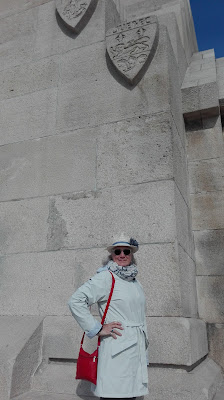If only this fear would leave me I could dream... and a hundred thousand thoughts of home would visit my heart in sleep; but here the peace is shattered all day by the devils will, and the guns bark night-long to spoil the velvet silence...Ivor Gurney
We had planned to arrive a day before the scheduled reception and meeting of the rest of the Metz Brats to be able to spend a day in Verdun. Here in the Great War 400,000 Frenchman died for their country on the fields around this ancient town. I had been here in the 60s and, as this was the 100th anniversary of the battles that changed forever the people, landscape and loyalties of this area, it was time again to revisit these sacred grounds and pay tribute to the heroes who laid down their lives there. Verdun was originally a Roman fortress, and typical of a fortified town has been invaded and besieged from Attila in 450 to the Prussians in 1792 to the Saxons in 1870, changing hands in later years back and forth from the French to the Germans. During the Great War of 1914 to 1918 Verdun was the scene of terrible fighting and destruction, not only of the town itself but surrounding villages, villages now known as "
les villages détruit". We rented a small car in Metz and drove for an hour to the tourist bureau in Verdun where we obtained a map of the '
champ des bataille'. Our first stop through the now wooded fields of battle was Fort Douaumont. This imposing fortress was lightly manned when attacked by the German infantry in February 1916. As it was an excellent observation post for the enemy who now occupied it, the French turned their heavy guns on it and in this hellish bombardment a shell caused a terrible fire in the fort which blew up an ammunition dump and annihilated a whole battalion of German soldiers. It was not recaptured by the French until December of that year.
 |
| on top of the fort |
 |
| shell holes show the intensity of the bombardment |
 |
| latrines, Fort Douaumont |
 |
| German memorial to over 400 men who died in the munition explosion inside the Fort |
 |
| French memorial |
From the fort it was a short drive to the Mortuary of Douaumont, a memorial to those who died on the battlefields near by. It is comprised of the imposing tower, the cloister and the Catholic chapel. This magnificent stone structure was begun in 1920 and formally unveiled in 1927. Atop the tower is a large bell and from the top, which we climbed, an extensive view over the whole battlefield lay before us. The cloister contains 46 tombs in which the remains of the unknown dead soldiers are assembled in accordance with the sectors in which they were found. On the interior walls are inscribed the names of those heroes who fought at Verdun. The ossuary itself contains the remains of more than 100,000 unknown soldiers of both the French and German armies and you can glimpse these century old bones through the many ground floor windows that surround the monument.
 |
| The mortuary and ossuary of Douaumont |

 |
| remains found on the battlefield |
Nearby is the La Tranchée des Baionnettes (Trench of Bayonets), a monument erected to the memory of the 137th regiment of the French army and the foot soldiers who were buried alive at that spot in June 1916. It was a very quiet spot except for the singing of birds and reminders of the heavy shelling were evident in the pitted ground of the woods that have since grown up around the battlefield. We returned to Metz shortly afterwards, our thoughts on the terrible destruction and death that happened 100 years ago. Hopefully our children and future generations will remember and honour those who fought and died for what they thought was a noble and right cause... Unfortunately it was not to be the war to end all wars. gws
 |
all that is left of the ruined village of Douaumont

|





























